Korean Air
Korean Air Co., Ltd. (Korean: 주식회사 대한항공; Hanja: 株式會社 大韓航空; RR: Jusikhoesa Daehan Hanggong), operating as Korean Air, is the largest airline and flag carrier of South Korea based on fleet size, international destinations and international flights. The airline's global headquarters is located in Seoul, South Korea. Korean Air was established on March 1, 1969, after the Hanjin Group acquired government-owned Korean Air Lines. Through their majority control of Hanjin KAL Corporation, the Cho family, the owner family of Hanjin Group is still the airline's largest and controlling, shareholder. Korean Air is a founding member of the SkyTeam airline alliance.
| |||||||
| Founded | 1969; 51 years ago | ||||||
|---|---|---|---|---|---|---|---|
| Hubs | |||||||
| Focus cities | |||||||
| Frequent-flyer program | SKYPASS | ||||||
| Alliance | |||||||
| Subsidiaries | Jin Air | ||||||
| Fleet size | 180 | ||||||
| Destinations | 150[2] | ||||||
| Parent company | Hanjin KAL Corporation (33.34%) (1969-present) | ||||||
| Traded as | KRX: 003490 | ||||||
| Headquarters | Gonghang-dong, Gangseo-gu, Seoul, South Korea | ||||||
| Key people | Walter Cho (Chairman & CEO) | ||||||
| Revenue | |||||||
| Operating income | |||||||
| Net income | |||||||
| Total assets | |||||||
| Total equity | |||||||
| Website | www.koreanair.com | ||||||
| Korean name | |
| Hangul | |
|---|---|
| Hanja | |
| Revised Romanization | Daehan Hanggong |
| McCune–Reischauer | Taehan Hanggong |
Korean Air's international passenger division and related subsidiary cargo division together serve 126 cities in 44 countries, while its domestic division serves 13 destinations. It is among the top 20 airlines in the world in terms of passengers carried and is also one of the top-ranked international cargo airlines. Incheon International Airport Terminal 2 serves as Korean Air's international hub. Korean Air also maintains a satellite headquarters campus at Incheon. The majority of Korean Air's pilots, ground staff, and flight attendants are based in Seoul. The airline had approximately 20,540 employees as of December 2014.[4]
History


Founding
Korean Air was founded by the South Korean government in 1962 as Korean Air Lines to replace Korean National Airlines, which was founded in 1946. On March 1, 1969, the Hanjin Group acquired the airline. Long-haul freight operations were introduced on April 26, 1971, followed by passenger services to Los Angeles International Airport on April 19, 1972.[5]
International flights to Hong Kong, Taiwan, and Los Angeles were flown with Boeing 707s until the introduction of the Boeing 747 in 1973. In 1973, the airline introduced Boeing 747s on its Pacific routes and started a European service to Paris, France using the 707 and then McDonnell Douglas DC-10. In 1975, the airline became one of the earliest Asian airlines to operate Airbus aircraft with the purchase of three Airbus A300s, which were put into immediate service on Asian routes.[6] Since South Korean aircraft were prohibited from flying in the airspace of North Korea and the Soviet Union at the time, the European routes had to be designed eastbound from South Korea, such as Gimpo-Anchorage-Paris.
Change to 'Korean Air'
A blue-top, silver and redesigned livery with a new corporate "Korean Air" logo featuring a stylized Taegeuk design was introduced on March 1, 1984, and the airline's name changed to Korean Air from Korean Air Lines. This livery was introduced on its Fokker F28 Fellowships and Boeing 747-300s. It was designed in cooperation between Korean Air and Boeing. In the 1990s, Korean Air became the first airline to use the new McDonnell Douglas MD-11 to supplement its new fleet of Boeing 747-400 aircraft; however, the MD-11 did not meet the airline's performance requirements and they were eventually converted to freighters. Some older 747 aircraft were also converted for freight service.
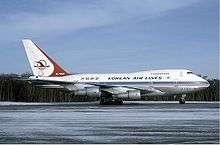

Further expansion and founding of Jin Air
In the 1980s, Korean Air's head office was in the KAL Building on Namdaemunno, Jung-gu, Seoul.[7]
On June 5, 2007, Korean Air said that it would create a new low-cost carrier called Jin Air in Korea to compete with Korea's KTX high-speed railway network system, which offered cheaper fares and less stringent security procedures compared to air travel. Jin Air started its scheduled passenger service from Seoul to Jeju on July 17, 2008. Korean Air announced that some of its 737s and A300s would be given to Jin Air.
By 2009, Korean Air's image had become more prestigious, differing from the airline's late-1990s image, which had been tarnished by several fatal accidents.[8]
In mid-2010, a co-marketing deal with games company Blizzard Entertainment sent a 747-400 and a 737-900 taking to the skies wrapped in StarCraft II branding. In August 2010, Korean Air announced heavy second-quarter losses despite record-high revenue.[9] In August 2010, Hanjin Group, the parent of Korean, opened a new cargo terminal at Navoi in Uzbekistan, which will become a cargo hub with regular Incheon-Navoi-Milan flights.[10]
Korean Air owns five hotels: two KAL hotels on Jeju island, the Hyatt in Incheon; Waikiki Resort in Hawaii, and a hotel/office building called the Wilshire Grand Tower in Los Angeles. This building in downtown Los Angeles houses the largest InterContinental Hotel in the Americas in what is the tallest building in Los Angeles.[11]
In 2013, Korean Air acquired a 44% stake in Czech Airlines.[12] It sold the stake in October 2017. On May 1, 2018, the airline launched a joint venture partnership with Delta Air Lines.[13]
Corporate affairs and identity
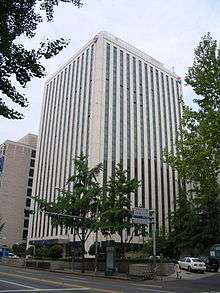
Korean Air's headquarters (대한항공 빌딩[14]) is located in Gonghang-dong, Gangseo-gu in Seoul. Korean Air also has offices at Gimpo International Airport in Seoul. Korean Air's other hubs are at Jeju International Airport, Jeju and Gimhae International Airport, Busan.[5] The maintenance facilities are located in Gimhae International Airport.
Destinations
Korean Air serves 126 international destinations in 44 countries on 5 continents, excluding codeshares. The airline's international hub is Incheon International Airport Terminal 2. The airline also flies to 13 domestic destinations. The airline operates between Incheon and 22 cities in mainland China, and along with Asiana Airlines, it is one of the two largest foreign airlines to operate into the People's Republic of China.[15]
Codeshare agreements
Korean Air has codeshare agreements with the following airlines:[16][17]
- Aeroflot
- Aerolíneas Argentinas
- Aeroméxico
- Air Europa
- Air France
- Air Tahiti Nui
- Alaska Airlines
- Alitalia
- American Airlines
- Aurora[18]
- China Airlines
- China Eastern Airlines
- China Southern Airlines
- Czech Airlines
- Delta Air Lines (Joint Venture Partner)[19]
- Emirates
- Etihad Airways
- Garuda Indonesia
- Gol Transportes Aéreos
- Hainan Airlines
- Hawaiian Airlines[20]
- Japan Airlines
- Jin Air (Subsidiary)
- Kenya Airways
- KLM
- LATAM Brasil[21]
- LATAM Chile
- LATAM Perú
- Malaysia Airlines
- MIAT Mongolian Airlines
- Myanmar Airways International
- Rossiya Airlines
- Royal Brunei Airlines[22]
- Saudia
- Shanghai Airlines
- Uzbekistan Airways
- Vietnam Airlines
- WestJet
- XiamenAir
Interline agreements
Korean Air has interline agreements with the following airlines:
Korean Air is also an airline partner of Skywards, the frequent-flyer program for Emirates. Skywards members can earn miles for flying Korean Air and can redeem miles for free flights.
Fleet
Current fleet
As of July 2020, the Korean Air fleet consists of the following aircraft:[24][25][26][27]
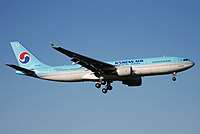
.jpg)
.jpg)
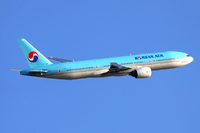
.jpg)
| Aircraft | In service | Orders | Passengers | Notes | |||
|---|---|---|---|---|---|---|---|
| F | P | E | Total | ||||
| Airbus A220-300 | 10 | — | — | — | 140 | 140 | Order with 10 options and 10 purchase rights[28] |
| Airbus A321neo | — | 30 | TBA | Order with 20 options.[29] | |||
| Airbus A330-200 | 8 | — | — | 30 | 188 | 218 | |
| Airbus A330-300 | 21 | — | — | 24 | 248 | 272 | |
| 24 | 252 | 276 | |||||
| 24 | 260 | 284 | |||||
| Airbus A380-800 | 10 | — | 12 | 94 | 301 | 407 | |
| Boeing 737-800 | 5 | — | — | 12 | 126 | 138 | |
| 135 | 147 | ||||||
| Boeing 737-900 | 16 | — | — | 8 | 180 | 188 | |
| Boeing 737-900ER | 6 | — | — | 12 | 147 | 159 | |
| Boeing 737 MAX 8 | — | 30 | TBA | Order with 20 options.[30] | |||
| Boeing 747-400 | 2 | — | 12 | 24 | 368 | 404 | |
| Boeing 747-8I | 10 | — | 6 | 48 | 314 | 368 | |
| Boeing 777-200ER | 13 | — | 8 |
28 |
212 | 248 | |
| 8 | 28 | 225 | 261 | ||||
| Boeing 777-300 | 4 | — | 6 | 35 | 297 | 338 | |
| Boeing 777-300ER | 26 | — | 8 | 42 | 227 | 277 | |
| 8 | 56 | 227 | 291 | ||||
| Boeing 787-9 | 10 | 10[31] | — | 24 | 245 | 269 | Order with 10 options.[32] Order was converted from 787-8.[33][34] |
| Boeing 787-10 | — | 20[31] | TBA | ||||
| Korean Air Cargo fleet | |||||||
| Boeing 747-400ERF | 4 | — | Cargo | ||||
| Boeing 747-8F | 7 | — | Cargo | ||||
| Boeing 777F | 12 | — | Cargo | ||||
| Korean Air Business Jet fleet[35][36] | |||||||
| AgustaWestland AW139 | 4 | — | 8–14 | ||||
| Boeing 737-700/BBJ1 | 1 | — | 16–26 | ||||
| Bombardier Global Express XRS | 1 | — | 13 | ||||
| Gulfstream G650ER | 1 | — | 13 | [37] | |||
| Sikorsky S-76+ | 1 | — | 5–6 | ||||
| Total | 172 | 90 | |||||
Retired fleet
Korean Air has operated the following aircraft:[38][39][40][41][42]
.jpg)

.jpg)
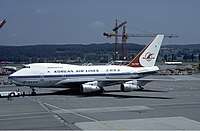
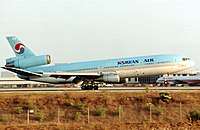
Fleet plans
At the Association of Asia Pacific Airlines Assembly in 2018, Korean Air announced that it was considering a new large widebody aircraft order to replace older Airbus A330, Boeing 747-400, Boeing 777-200ER and Boeing 777-300. Types under consideration for replacement of older widebody aircraft in the fleet include the Boeing 777X and Airbus A350 XWB.[43]
At the International Air Transport Association Annual General Meeting (IATA AGM) in Seoul, Chairman Walter Cho said Korean Air's widebody order is imminent and it is considering an extra order of Airbus A220 Family including developing version, Airbus A220-500.[44]
Aircraft interiors
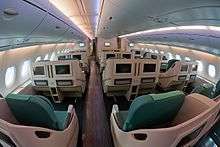

Korean Air currently offers three types of first class, four types of business (Prestige) class, and standard economy class.[45]
First Class
First Class seats include "Kosmo Suites 2.0" seats on all Boeing 747-8I and many 777-300ER models. "Kosmo Suites" seats are fitted on most of the Airbus A380-800 fleet as well as some of the Boeing 777-200ER and -300ER fleet; the differences between "Kosmo Suites 2.0" and "Kosmo Suites" is that "Kosmo Suites 2.0" has a sliding door to provide the passenger with better privacy. Some Boeing 777-300ER models are fitted with the newer "Kosmo Suites 2.0". "Kosmo Sleeper" seats are fitted on some Boeing 777-200ER aircraft. "Sleeper" first class seats are older than Kosmo First Class models and are equipped on Boeing 747-400 and later Boeing 777-300 models.
Prestige Class
Prestige Class seats include new "Prestige Suites" that focuses on the design of the Apex Suites. This business class model is equipped on all Boeing 747-8i and 787-9, as well as most 777-300ER aircraft. "Prestige Sleeper" seats are fitted on some Boeing 777-300ERs and Airbus A380s, as well as 777-200ER aircraft that feature "Kosmo Suites" first class seats; "Prestige Plus" seats are fitted on most of the Boeing 777-200ER fleet, most of the Boeing 747-400 fleet, and one Boeing 777-300; "Old Prestige Class" seats are currently being phased out in aircraft that are equipped with it (with the exception of the Boeing 737 family). "Prestige Sleeper" and "Prestige Suites" seats recline to 180 degrees, while "Prestige Plus" seats recline up to 172 degrees. "Old Prestige Class" seats recline up to 138 degrees.
Premium Economy Class
On 27 December 2017, CEO of Korean Air, Won-Tae Cho said to consider to introduce Premium Economy Class.[46] In that result, Korean Air introduced its first Premium Economy Class named "Economy Plus" on its CS300 (Airbus A220-300). It features seats that are 4 inches wider than standard economy class seats.[47] However, on 10 June, 2019, Korean Air announced to disuse the "Economy Plus"; it will be reassigned to economy class due to discordance of service and profit loss.[48][49]
Economy Class
Economy Class seats recline up to 121 degrees. A new type of seat called "New Economy Class" is being installed on all Boeing 777-300ER and Boeing 777-200ER aircraft with Kosmo Suites, all Boeing 777-300 aircraft, some Airbus A330-300 aircraft, some Airbus A330-200 aircraft, the Airbus A380 aircraft (factory-installed), and brand new Boeing 747-8i aircraft. The "Kosmo Suites" seats and the "Prestige Sleeper" seats were first introduced in the Boeing 777-300ERs in May 2009.[50] Both seats could stretch to 180 degrees, and became more private than seats before.
Loyalty program
SKYPASS is the frequent-flyer program of Korean Air. "SKYPASS" also refers to the blue card which Korean Air frequent-flyers are given. The motto of SKYPASS is "Beyond your Imagination". The program's elite levels are comparable to those of other airlines' frequent-flyer programs, requiring members to fly 30,000 miles per two-year cycle (initial entry into this level requires 50,000 miles). Qualification for the highest level is based on lifetime flight miles, requiring a customer to fly 1 million miles for Million Miler, which is the highest elite status; or 500,000 miles for Morning Calm Premium, which comes second. Both membership levels are eligible for SkyTeam Elite Plus privileges. Membership in these levels are granted for life.
Korean Air members’ club was named Morning Calm, as a reference to South Korea’s tradition. Since 1886, when a book written by Percival Lowell obtained large success in the United States in narrating the history of Korea, the country started to be internationally referred as “the Land of Morning calm”,[51] and its ruling monarchy the Joseon, became known abroad as the “Morning Dynasty”.
Aerospace research and manufacturing
Korean Air is also involved in aerospace research and manufacturing. The division, known as the Korean Air Aerospace Division (KAL-ASD), has manufactured licensed versions of the MD Helicopters MD 500 and Sikorsky UH-60 Black Hawk helicopters, as well as the Northrop F-5E/F Tiger II fighter aircraft,[52] the aft fuselage and wings for the KF-16 fighter aircraft manufactured by Korean Aerospace Industries and parts for various commercial aircraft including the Boeing 737, Boeing 747, Boeing 777 and Boeing 787 Dreamliner; and the Airbus A330 and Airbus A380.[53] In 1991 the division designed and flew the Korean Air Chang-Gong 91 light aircraft. KAA also provides aircraft maintenance support for the United States Department of Defense in Asia and maintains a research division with focuses on launch vehicles, satellites, commercial aircraft, military aircraft, helicopters and simulation systems.[54]
In October 2012, a development deal between Bombardier Aerospace and a government-led South Korean consortium was announced, aiming to develop a 90-seat turboprop regional airliner, targeting a 2019 launch date. The consortium would include Korea Aerospace Industries and Korean Air.[55]
Incidents and accidents
Korean Air had a poor safety record and was once one of the world's most dangerous airlines.[56][57] Between 1970 and 1999, many fatal incidents occurred, during which time 16 aircraft were written off in serious incidents and accidents with the loss of 700 lives. Two Korean Air aircraft were shot down by the Soviet Union, one operating as Korean Air Lines Flight 902 and the other as Korean Air Lines Flight 007. Korean Air's deadliest incident was Flight 007 which was shot down by the Soviet Union on September 1, 1983. All 269 people on board were killed, including a sitting U.S. Congressman, Larry McDonald. The last fatal passenger accident was the Korean Air Flight 801 crash in 1997, which killed 228 people. The last crew fatalities were in the crash of Korean Air Cargo Flight 8509 in December 1999.[58]
Controversy & Criticism
Chaebol and nepotism
Korean Air has been cited as one of the examples of the South Korean "chaebol" system, wherein corporate conglomerates, established with government support, overreach diverse branches of industry. For much of the time between the foundation of Korean Air as Korean National Airlines in 1946 and the foundation of Asiana Airlines in 1988, Korean Air was the only airline operating in South Korea. The process of privatization of Korean National Airlines in 1969 was supported by Park Chung-hee, the South Korean military general-president who seized power of the country through a military coup d'état; and the monopoly of the airline was secured for two decades. After widening the Jaebeol branches, the subsidiary corporations of Korean Air include marine and overland transportation businesses, hotels and real estate among others; and the previous branches included heavy industry, passenger transportation, construction and a stockbroking business. The nature of the South Korean chaebeol system involves nepotism. A series of incidents involving Korean Air in 2000s have "revealed an ugly side of the culture within chaebeols, South Korean’s giant family-run conglomerates".[59]
Nut-rage incident
Cho Hyun-Ah, also known as "Heather Cho", is the daughter of then-chairman Cho Yang-ho. She resigned from some of her duties in late 2014 after she ordered a Korean Air jet to return to the gate to allow a flight attendant to be removed from the aircraft. The attendant had served Cho nuts in a bag instead of on a plate. As a result of further fallout, Cho Hyun-Ah was later arrested by Korean authorities for violating South Korea's aviation safety laws.[60]
See also
References
- "JO 7340.2J - Contractions - Including Change 1" (PDF). Federal Aviation Administration. October 10, 2019. p. 3-1-53. Retrieved November 22, 2019.
- "Airline Insight: Korean Air". blueswandaily.com. November 14, 2018. Retrieved November 14, 2018.
- "korean air lines co ltd (003490:Korea SE)". businessweek.com. Retrieved September 1, 2014.
- "Who We Are - Korean Air". koreanair.com. Retrieved June 14, 2016.
- "Directory: World Airlines". Flight International. April 3, 2007. p. 102.
- "Korean Air Lines Co., Ltd. History Archived May 22, 2012, at the Wayback Machine". International Directory of Company Histories, Vol. 27. St. James Press, 1999.
- "World Airline Directory." Flight International. May 16, 1981. 1444.
- Yu, Roger (August 26, 2009). "Korean Air upgrades service, image". USA Today. Retrieved September 16, 2009.
- "Korean Air slides to second quarter loss but touts 'record high' revenue". ATW Online. August 16, 2010. Retrieved August 16, 2010.
- "Navoi Cargo Terminal opens in Uzbekistan; Korean Air to expand cargo network". ATW Online. August 16, 2010. Retrieved August 16, 2010.
- Vincent, Roger (September 23, 2014) "Hotel under construction in downtown L.A. will be an InterContinental" Los Angeles Times
- Hovet, Jason; Hepher, Tim (April 10, 2013). "Korean Air finalises investment in loss-making Czech Airlines". Reuters. Retrieved August 4, 2015.
- "Korean Air-Delta joint venture to boost air traffic". koreatimes. May 1, 2018. Retrieved December 2, 2019.
- "일반현황 / 기업개요". Korean Air. Retrieved September 9, 2010. "주소: 서울 특별시 강서구 공항동 1370번지 대현항공 빌딩"
- "Why Nearly Half of Asiana Passengers Were Chinese." The Wall Street Journal. July 7, 2013. Retrieved on July 19, 2013.
- "Korean Air codeshare partners". Korean Air. Retrieved July 4, 2017.
- "Profile Korean Air". CAPA. Centre for Aviation. Archived from the original on October 29, 2016. Retrieved October 29, 2016.
- "Korean Air / Aurora begins codeshare partnership from July 2018". Routesonline. July 12, 2018.
- "Delta and Korean Air to expand partnership". Delta Air Lines. Retrieved March 29, 2017.
- Hawaiian Airlines (March 22, 2011). "Hawaiian Airlines, Korean Air Team Up On Frequent Flyer Benefits". Hawaiian Airlines. Retrieved April 25, 2017.
- "Korean Air expands LATAM codeshare to Brasil in Nov 2018". Routesonline. November 29, 2018.
- "Korean Air is Royal Brunei Airlines' latest codeshare partner". Royal Brunei Airlines. September 4, 2019.
- "JetBlue and Korean Air Announce New Interline Agreement to Connect Customers Between Asia and North America". PR Newswire. February 28, 2012.
- "Business Jet Services". Korean Air. Retrieved August 18, 2016.
- "항공기 등록현황". Ministry of Land, Infrastructure and Transport of Korea (in Korean).
- "Korean Air Lines Fleet Details and History". planespotters.net. December 30, 2016. Retrieved December 30, 2016.
- "Korean Air fleet and seat maps". Korean Air. Retrieved June 1, 2018.
- "Korean Air becomes the third operator of the Bombardier CS300". World Airline News. December 22, 2017.
- "Korean Air finalises order for 30 A321neo" (Press release). Airbus. November 6, 2015.
- "Boeing, Korean Air Announce Airline's Intent to Purchase 30 737 MAXs" (Press release). Boeing. June 16, 2015.
- "Korean Air to Introduce Boeing 787-10 for First Time in Korea" (Press release). Korean Air. June 19, 2019.
- "Korean Air Joins Boeing 787 Family with up to 20-Airplane Order". Boeing. April 11, 2005.
- "Boeing Delivers Korean Air's First 787-9 Dreamliner". February 22, 2017. Retrieved February 22, 2017.
- Ghim-Lay Yeo. "Korean Air converts 10 787-8s to -9s". Singapore: Flight International. Archived from the original on March 21, 2011. Retrieved December 23, 2016.
- "Korean Air business jet fleets". Korean Air.
- Greg Waldron (October 18, 2016). "Korean Air expands business jet charter unit". FlightGlobal.
- "Korean Air adds maiden Gulfstream G650ER". Ch-Aviation. August 3, 2016.
- "대한항공 50년 보유 항공기 변천사(1) 1960~1980년대". Korean Air (in Korean). April 30, 2019.
- "대한항공 50년 보유 항공기 변천사(2) 1990년대 ~ 현재". Korean Air (in Korean). April 30, 2019.
- "Korean Air Lines Fleet Details and History". planespotters.net. June 26, 2018.
- "연도별 도입 현황". Ministry of Land, Infrastructure and Transport of Korea (in Korean).
- "연도별 말소 현황". Ministry of Land, Infrastructure and Transport of Korea (in Korean).
- "Korean Air Mulling 'Large' Widebody Jet Order for Expansion". Bloomberg. October 19, 2018.
- "Korean Air widebody order "imminent", eyes more A220s". Ch-Aviation. June 11, 2019.
- "On-Board / Classes of Service". Korean Air.
- "조원태 대한항공 사장 "프리미엄 이코노미석 도입 검토"" (in Korean). Yonhap News Agency. December 27, 2017.
- "Korean Air Introducing Premium Economy Seating to Its Fleet". Rus Tourism News. December 28, 2017.
- "대한항공, 내달 10일부터 '이코노미 플러스석' 폐지" (in Korean). Yonhap News Agency. May 22, 2019.
- "대한항공, 6월10일부터 '이코노미 플러스석' 폐지···예매 고객 '차액 환불'" (in Korean). The Asian. May 23, 2019.
- "Korean Air introduces premium seats" (in Korean).
- "The Land of the Morning Calm". Unesco.org. November 26, 2018.
- "Korean Air Aerospace Division (KAA)". GlobalSecurity.org. Retrieved April 29, 2013.
- Carrier moonlights in aerospace. Los Angeles Times. (February 18, 2007).
- Korean Air Aerospace Division Official Website Archived September 29, 2007, at the Wayback Machine. Kal-asd.com.
- Choi, Kyong-Ae (October 8, 2012). "South Korea Consortium in Talks With Bombardier About Developing Passenger Plane". Wall Street Journal. Retrieved December 23, 2016.
- See Malcolm Gladwell, Outliers (2008), pp. 177–223 for a discussion of this turnaround in airline safety. Gladwell notes (p. 180) that the hull-loss rate for the airline was 4.79 per million departures, a full 17 times greater than United Airlines which at the same time had a loss rate of just 0.27 per million departures.
- Stanley, Bruce (January 9, 2006). "Korean Air Bucks Tradition To Fix Problems". wsj.com. The Wall Street Journal. Retrieved April 11, 2019.
- Kirk, Don (March 26, 2002). "New Standards Mean Korean Air Is Coming Off Many 'Shun' Lists". The New York Times. Retrieved September 23, 2009.
- Pasick, Adam (December 9, 2014). "Nepotism in a Nutshell". The Atlantic. Retrieved December 23, 2016.
- "Ex-Korean Air Executive Arrested Over 'Nut Rage' Incident". NPR.org. December 30, 2014. Retrieved April 24, 2015.
External links
![]()